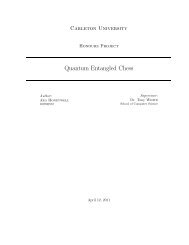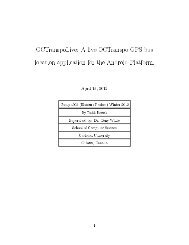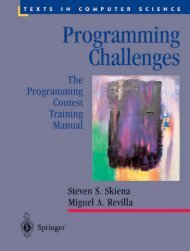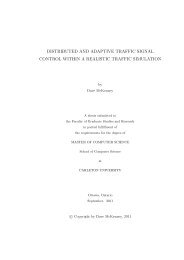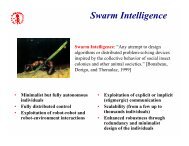Implement a simulator, in Java, for evaluating AntNet routing protocol
Implement a simulator, in Java, for evaluating AntNet routing protocol
Implement a simulator, in Java, for evaluating AntNet routing protocol
Create successful ePaper yourself
Turn your PDF publications into a flip-book with our unique Google optimized e-Paper software.
Figure 4: The example networkFigure 4 shows a target system of seven nodes and eight l<strong>in</strong>ks objects. Each l<strong>in</strong>k isconnected to exactly two nodes. A node models the physical aspects of a store and <strong>for</strong>wardentity such as a host or a switch. Each node is connected to an SPF rout<strong>in</strong>g algorithm andzero or more workload components. Each workload component is either a source or a s<strong>in</strong>kof FTP. For each source object, there is a correspond<strong>in</strong>g "peer" s<strong>in</strong>k object. There is onel<strong>in</strong>k-cost function object which is not connected to any one.I briefly describe each type of object <strong>in</strong> the follow<strong>in</strong>g.L<strong>in</strong>kA l<strong>in</strong>k object models a bidirectional transmission channel between two node objects. I usethe same data structure to implement L<strong>in</strong>k class as L<strong>in</strong>k Component <strong>in</strong> the MaRS. Eachl<strong>in</strong>k object conta<strong>in</strong>s two L<strong>in</strong>kedLists of packets, each represent<strong>in</strong>g the packets <strong>in</strong> the transit<strong>in</strong> one direction. A l<strong>in</strong>k can be subject to failure and fails. When a l<strong>in</strong>k fails, all packets thatare <strong>in</strong> transit are lost.The <strong>in</strong>put parameters of l<strong>in</strong>k are Propagation delay[microseconds], Bandwidth



